Biwa Pearl Bracelet
Open FREE Unlimited Store Join Our Newsletter
Lareef A. Samad B.Sc.(Hons)
Origin of Name
The name refers to the extraordinary nine-strand pearl bracelet composed of Biwa pearls that drew international attention, after its exposition as part of an international traveling exhibition organized by the American Museum of Natural History, in collaboration with the Chicago Field Museum, known as "Pearls : A Natural History," which was hosted for the first time in October 2001 by the American Museum of Natural History, New York, and subsequently by other museums in the United States and countries like Canada, France, Japan, Australia, and the United Arab Emirates. The Biwa Pearl Bracelet, property of Jill Gindoff Cashman was given on loan to the American Museum of Natural History for the purpose of the exhibition. "Biwa pearls" refer to freshwater pearls cultured inside a species of freshwater mussel found in the Biwa Lake in Japan, which incidentally were the first pearls ever to be cultured inside freshwater mussels, and hence the name "Biwa Pearls" at one time came to be synonymous with all freshwater pearls irrespective of their origin.

The Biwa Pearl Bracelet
© Australian Museum
Characteristics of the Bracelet
Jill Gindoff Cashman's Biwa Pearl Bracelet, was designed in the 1950s at New York, and is made up of cultured Biwa pearls and gold. The bracelet is made up of nine cultured Biwa pearl strands, each strand consisting of an average of 20 pearls. The pearls have the characteristic features of Biwa pearls, being non-nucleated cultured pearls almost entirely made of nacre, and having the luster and brilliance of natural saltwater pearls. They are small having the average size of about 5-6 mm, the normal size of Biwa pearls produced during this period. Most of the pearls are irregular in shape, another characteristic of tissue nucleated Biwa pearls. However a multitude of other shapes can also be recognized out of the approximately 180 pearls in the bracelet, such as rounds, near-rounds, ovals, drops, buttons, triangles, rectangles, quadrilaterals etc.
The nine strands of the bracelet extend from the circular gold work studded with six spherical Biwa pearls, at one end to the clasp at the other end. When the bracelet is tied around the wrist, the clasp will fit in below the circular gold work, which forms the centerpiece of the bracelet.
Shape of Biwa pearls
Biwa peals are generally irregular (baroque) in shape, but they also exist in a variety of different shapes such as rounded, near-round, button, oval, elongated (dogtooth), flat, grain etc. By varying the size and shape of the mantle tissues implants, it was possible to produce sometimes bizarre fancy shapes, such as bars, double bars, cross-over bars, crosses, dragons, sticks, buttons, triangles, butterflies, shapes with a jagged outline, letters of the alphabet, etc.
Size of Biwa pearls
The pearls are small with an average diameter of about 5-6 mm. This is associated with the short period of growth after implantation, which is 1-2 years.
Color of Biwa pearls
The color and luster of Biwa pearls, said to be identical or surpassing that of natural saltwater pearls, is clearly associated with their all nacre body free of nuclei. The common colors of Biwa pearls are white, pink and orange. Apart from this they also occur in fancy colors, such as lilac, wine, green and blue, and colors such as cream, silver, brown and gray.
Luster of Biwa pearls
Luster of a pearl which is its reflective property is also associated with the thickness of the nacre. Thus Biwa pearls being all nacre undoubtedly has an extraordinary luster that rivals that of natural saltwater pearls.
History of Biwa Pearls
Mikimoto's success in culturing saltwater pearls
In the year 1916, Mikimoto who had been doing extensive research on culturing spherical saltwater pearls since 1888, finally adopted the "Mise-Nishikawa" method of culturing spherical pearls, and successfully cultured several spherical saltwater pearls using the saltwater oyster species Pinctada martensii. The method that involved the insertion of a piece of mantle tissue together with the shell nucleus into the oysters mantle or body, was found to be commercially viable, and resulted in a major breakthrough for the Japanese cultured pearl industry. By the year 1935, Japan had 350 pearl farms producing 10 million cultured pearls annually.
Fujita's attempts at culturing freshwater pearls applying the same techniques perfected for saltwater pearls
Following the successful culturing of salt water pearls using the "Mise-Nishikawa" method, attention was diverted towards the culturing of freshwater pearls inside freshwater mussel species, found abundantly in the lakes and rivers of Japan. In the year 1928, Dr. Masao Fujita, a friend and associate of both Mikimoto and Nishikawa, made the first attempt to culture whole freshwater pearls inside a common freshwater mussel species Hyriopsis schelegi, found in the largest and most ancient freshwater lake in Japan, Lake Biwa, situated about 10 km north of Kyoto, in the Shiga Prefecture. Lake Biwa-ko is fed by a multitude of rivers that originate in the surrounding mountains of Hira, Ibuki and Suzuka. Fujita adopted the same "Mise-Nishikawa" technique that was successfully applied in the culturing of saltwater pearls. However, the results obtained were not so encouraging. Fujita and his co-worker Yoshida were undeterred, and continued research into the culturing of freshwater pearls throughout the 1930s, and achieved limited success in culturing sub-standard bead nucleated pearls. Several thousand pearls were harvested by Fujita, and these early Biwa pearls were almost universally elongated and baroque. The pearls were also quite small, with an average size of about 5 mm. Dr. Fujita sold almost all his pearl harvest to the Mikimoto's Tokyo pearl store.
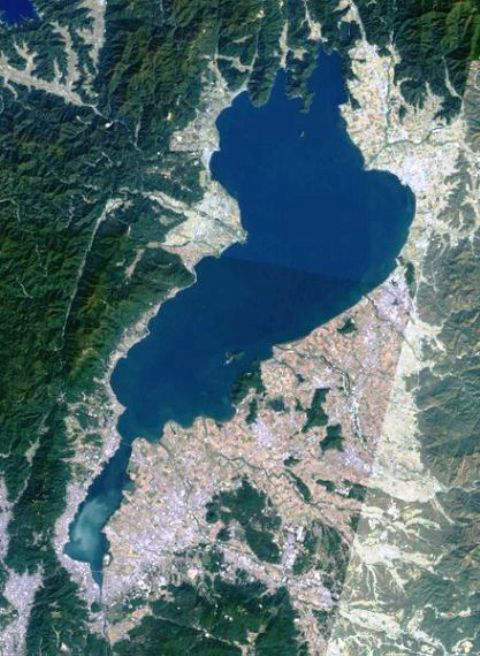
Lake Biwa from outer space
Seiishiro Udo and Keisaburo Sakiyoshi perfect the technique of culturing non-nucleated freshwater pearls, that came to be known as Biwa pearls
Dr. Fujita and Yoshida made an accidental but very significant discovery during their research work, viz. that mantle tissue accidentally implanted in this mussel could initiate pearl growth. Unfortunately, they did not pursue this research further, and it was left to two other research workers, Seiishiro Udo and Keisaburo Sakiyoshi, who beginning from the year 1945, experimented with freshwater pearl culture using the freshwater mussel Hyriopsis schelegi and perfected the technique of non-nucleated pearl production, using mantle tissue only. Their research was carried out in the Hirako reservoir, a dammed arm of Lake Biwa, near the village of Shina. Their efforts were successful only in the early 1960s, and they formed the Shinko Pearl Company, who were the first commercial producers of freshwater pearls, that came to be known as Biwa Pearls.
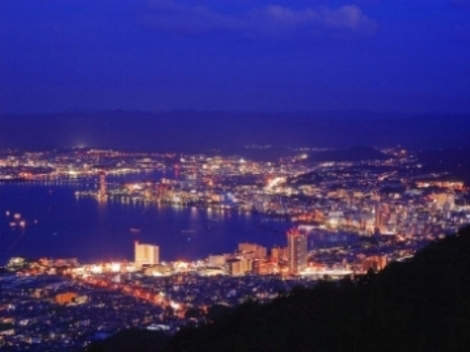
Lake Biwa and the city of Otsu
Culturing of non-nucleated freshwater pearls in Lake Kasumigaura and Lake Gifu
While extensive culturing of non-nucleated freshwater pearls using the freshwater mussel species Hyriopsis schlegeli began in the early 1960s in the Lake Biwa, almost simultaneously culturing was also carried out in two other lakes, Kasumigaura in Ibaraki Prefecture, 70 km northeast of Tokyo, and Gifu near Lake Biwa to the north of Nagoya. In the case of Lake Kasumigaura, the second largest lake in Japan, Hyriopsis schlegeli which was not native to the lake, was transferred from Lake Biwa during the 1930s, and a significant population established by the 1950s. When the culture of mantle grafted freshwater pearls began in the early 1960s in the Biwa Lake, commercial cultivation of Biwa pearls also began in Lake Kasumigaura in 1963, with around 180,000 mussels being harvested and implanted during that year.
Catastrophic decline in production of Biwa pearls after 1980, caused by multiple factors
By the year 1970, the total production of tissue-grafted freshwater pearls from Lake Biwa and other secondary sources, reached an all time high of 6.3 tons, the highest ever achieved for Biwa pearls. Production declined rapidly thereafter due to devastating environmental pollution of the lakes caused by industrial effluents and agricultural pollutants reaching the lakes through their feeder rivers and streams, which was detrimental to the mussel populations. Apart from this habitat loss, over fishing and invasion of exotic species of fish that threatened the survival of the host fish for the gloichidia, also contributed to the rapid decline in population of mussels. and In the year 1998, the total production of Japanese mantle-grafted Biwa freshwater pearls was only 214 kg.
Attempts made by pearl farmers to overcome the problem of pollution
It appeared that the early developmental stages of the Hyriopsis mussels were more susceptible to environmental pollutants than the adult mussels. Thus pearl farmers resorted to cultivating spat-bred Hyriopsis schlegeli in artificial freshwater ponds, and implanting them after the mussels had reached adulthood. The implanted mussels were eventually returned to the polluted freshwater lakes, and left for the stipulated grow out period. The results obtained were only partially successful.
Some of the desperate pearl farmers who were not able to cope with the pollution problems relocated to China, a vast country where a multitude of pollution-free freshwater bodies were available for successful pearl cultivation. They based their non-nucleated freshwater pearl culturing on the local mussel species found in China known as Hyriopsis cumingii.
Another strategy adopted by scientists and pearl farmers in overcoming the problem was the introduction of a hybrid pearl mussel, created by crossing the Japanese pearl mussel, Hyriopsis schlegeli with the Chinese pearl mussel, Hyriopsis cumingi, to the freshwater lakes where pollution was relatively less, such as the Lake Kasumigaura.

Lake Kasumigaura
Cultivation of freshwater pearls in the Lake Kasumigaura
Culturing of non-nucleated freshwater Biwa pearls in the Lake Kasumigaura started in 1963, but soon production declined rapidly due to over exploitation, pollution and eutrophication, and almost completely ceased in the early 1980s. With a view of reviving the industry pearl farmers developed a hybrid variety between the Japanese and Chinese freshwater mussels (Hyriopsis schlegeli/Hyriopsis cumingi), and introduced it into the Lake Kasumigaura, the least polluted of the lakes in Japan. The new hybrid variety of freshwater mussel was said to be somewhat resistant to pollution, and were also able to accept a round nucleus. In 1993, the first crop of experimental pearls were produced and their quality rivaled that of the famous Biwa pearls, with a beautiful luster and highly desirable color in different shades of rose pink, purple, white and cream. The cultivation period of the "Kasumiga pearls" was four years, the longest for any cultivated pearl. Thus the first marketable crop of "Kasumiga pearls" were produced only in 1997, four years after the first experimental crop. The high quality of Kasumiga pearls is necessarily associated with the thickness of its nacre, which should be considerable given the long period of growth of the pearl. The extraordinary color and luster of the pearls are undoubtedly associated with the thickness of the nacre. The size of the pearls are also large varying from 11-16 mm. Thus the combination of desirable color, luster and size have made "Kasumiga pearls" one of the most sought after pearls in the world.
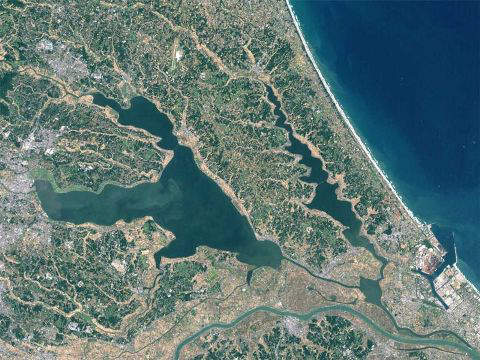
Lake Kasumigaura- satellite photo
Multiple implantation of Hyriopsis schlegeli
A significant difference between saltwater pearl culturing and freshwater pearl culturing is that while in the former the saltwater oyster is usually implanted only with a single bead nucleus, in the latter the freshwater mussel is implanted with multiple tissue nuclei, sometimes as high as forty implantations per mussel. This explains why the Chinese cultured pearl industry based on the freshwater mussel species Hyriopsis cumingi, has overtaken all other cultured pearl industries in the world, within a short period of time.
In Japan in the culturing of Biwa pearls, initially the mussel species, Hyriopsis schlegeli was grafted with 21 implants of mantle tissue :- five inside the body and eight on each side of the mantle. This method, especially implantation inside the body, needed special technical skills, and therefore was replaced by the present standard implantation technique, that makes use of only the mantle on both sides of the valves, for implantation. In this technique forty pieces of mantle tissue, from a sacrificial mussel, is implanted in two rows of ten, on each side of the mantle. The implanted mussel is returned to its natural aquatic environment and left for around two years, the usual grow out period for the cultured Biwa pearls.
The use of the term Biwa pearls
Initially the term Biwa pearls was used only for freshwater pearls cultured from the mussel species Hyriopsis schlegeli in the Biwa Lake, the largest and most ancient lake in Japan. Later the term was extended to include freshwater pearls cultured from the same species in other lakes such as Kasumigaura and Gifu. Eventually the term was used for all freshwater pearls produced in Japan irrespective of their origins. Biwa pearls were the first freshwater pearls to be cultured in a freshwater mussel, and received world wide recognition and acceptance. Thus the term Biwa pearls became synonymous with all freshwater pearls irrespective of the country of origin. In the United States the use of the term Biwa Pearls is restricted only to freshwater pearls originating in the Biwa Lake of Japan. The use of the term to refer to freshwater pearls from other sources in Japan or from other countries is illegal.

Close up of some Lake Biwa Pearls
The freshwater mussel Hyriopsis schlegeli
Classification of Hyriopsis schlegeli (Martens 1861)
Kingdom : Animalia
Phylum : Mollusca
Class : Bivalvia
Sub-Class : Palaeoheterodonta
Order : Unionoida
Super-Family : Unionoideae
Family : Unionidae
Genus : Hyriopsis
species : schlegeli
Common names : Ikecyo-Gai (Japanese)
Biwa Pearly Mussel

Hyriopsis schlegeli - Biwa Pearly Mussel
Reproduction in Hyriopsis schlegeli
In freshwater mussels the sexes are separate. Mature male mussels release sperms into the surrounding water, some of which may be drawn into the female mussel through the incurrent siphon. The female's eggs are located in the water tubes of the gills, where they get fertilized by the incoming sperms and develop into glochidia, the larval form of the mussel. The glochidia are not fully developed and its further development depends on whether it can attach itself successfully to the gills or fins of a suitable host fish after being released by the female mussel. In the case of Hyriopsis schlegeli out of the several fish species found in Lake Biwa, that has been identified as hosts for the glochidia, one example is "trident goby" (Tridentiger kuroiwae). The glochidia encyst on the gill filaments, where they metamorphose into juvenile mussels. The time taken for the transformation into juvenile mussels depends on several factors including water temperature, and can vary from a few days to several weeks. The juvenile mussels drop off the gills or fins of the host fish, and if they fall on a suitable habitat, they will grow and develop into adults to continue the life cycle.
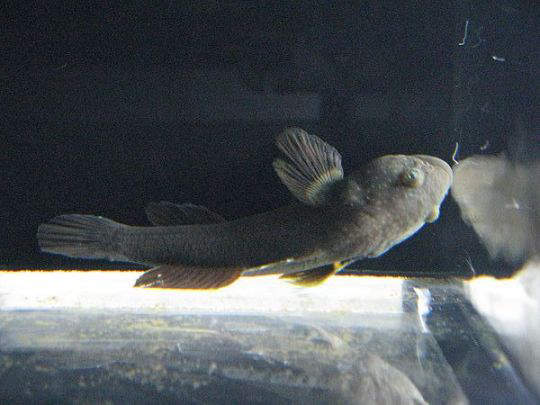
Tridentiger kuroiwae - trident goby, endemic fish species in Lake Biwa identified as a host for glochidia of Hyriopsis schlegeli
The Biwa pearl mussel is a large, slow growing, phytoplankton-feeding, freshwater mussel taking around 6-7 years to attain full maturity. The size of the shell gives an indication of the state of maturity of the mussel. Mussels are fully matured when the size of the shell is 70 mm (7 cm). However a fully grown Biwa pearl mussel can attain a size of up to 13-16 cm. The mussels are long lived and if left undisturbed can live up to the age of over 40 years. The external surface of the mussel is dark greenish-brown in color. The internal surface of the valves are coated with high-quality lustrous nacre. Depending on the season of the year, these mussels could lie either partly or fully embedded in the sand and mud on the bottom of the lake.
Was environmental pollution the only reason for the collapse of the Biwa cultured pearl industry ?
The Biwa Pearly Mussel is a species of Unionidae mussels endemic to the Lake Biwa and its satellite lakes, in the Shiga prefecture of Japan. The lake was also host to many endemic fish species, that served as hosts to the glochidia larvae of the pearl mussels, which was crucial for the completion of their life cycle. The mussel is long lived with a life span of over 40 years, and was the first freshwater mussel in the world to be exploited for artificial pearl culture. The human population that inhabited the immediate surroundings of the lake was 1.3 million.
The Biwa pearly mussels were harvested and the mature mussels (shell size greater than 7 cm) were tissue implanted before returning to the water to begin the culturing process, that lasted from 1 to 2 years. In the early 1970s the catch of mussels were over 10 metric tons (10,000 kg), which was maintained with minor fluctuations until the early 1980s, after which production decreased drastically to less than one metric ton in the mid-1980s, less than 100 kg in 1990 and collapsed completely in 1992. With the collapse of the mussel harvests the cultured pearl industry based on the Biwa pearly mussel also totally collapsed.
Environmental degradation was found to be the main factor responsible for the wiping out of mussel populations in the lake, caused by industrial effluents and agricultural chemicals finding their way into the lake through the multitude of rivers flowing into the lake from the surrounding hills. The chemical pollutants were more detrimental towards the early developmental stages of the mussels, such as the glochidia larvae, the juvenile mussels, and the immature mussels less than 6-7 years old, and with a shell length of less than 7 cm. This had a devastating effect on the population of adult mussels suitable for implantation.
However, apart from environmental degradation other contributory factors have also been identified, that was responsible for the collapse of the industry. Some of these factors are :- 1) Habitat loss 2) Eutrophication 3) Overfishing 4) Invasion of exotic species
1) Habitat Loss
The Biwa pearly mussels live in the bottom of the lake, either partly or fully embedded in the sand and mud. Various regions of the lake have been subjected to dredging periodically, and this resulted in the loss of habitat for bottom dwellers of the lake, mainly the freshwater mussels. One region that was dredged thoroughly with a serious loss of habitat for the mussels was the south basin of the lake.
2) Eutrophication
Sections of the Lake had been subjected to eutrophication from time to time, that was detrimental to other aquatic organisms living in the lake, such as fishes, and mussels. Eutrophication results when the lake receives excess nutrients such as fertilizers from surrounding agricultural fields, discharges from sewage treatment plants and soil nutrients by erosion. Excess nutrients stimulate excessive plant growth, such as algae and aquatic weeds, often known as an algal bloom. The algal bloom itself is not detrimental to other living organisms; however, when dead plant material decompose the concentration of dissolved oxygen in the water is drastically reduced, causing the death of other living organisms in the water, like fishes and mussels.
3) Overfishing
Continuous over harvesting of mussels from the early 1970s to 1980s, that resulted in a catch of 10 metric tons annually, coupled with the slow growth rate and recruitment of mussels, caused a drastic decline in the adult populations of the mussel. Given the fact that the mussels took 6-7 years to attain maturity, the continuous harvesting of adult mussels, without giving sufficient time for the younger ones to regenerate had a devastating effect on the population.
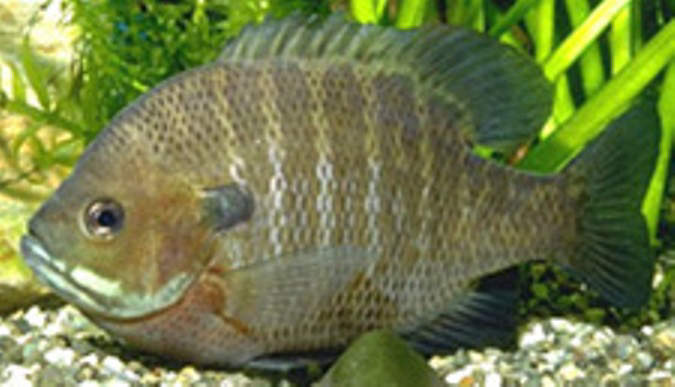
Blue Gill - Lepomis macrochirus, an exotic species introduced into Lake Biwa, that multiplied rapidly threatening the existence of many endemic fish species
4) Invasion of exotic species
The introduction of exotic species into the lake was also a contributory factor. In the 1960s the fish known as blue gill (Lepomis macrochirus) was introduced into Japanese lakes. While being a source of food, the blue gill was also expected to be a suitable host for the glochidium larvae of the Biwa pearly mussel. However, contrary to expectations the blue gill instead of becoming a host fish to the glochidium larvae, threatened the existence of many native host fishes of the Biwa pearly mussel in the 1980s. Exotic fishes could threaten the native fishes by being more aggressive, and competing for the same source of food.
You are welcome to discuss this post/related topics with Dr Shihaan and other experts from around the world in our FORUMS (forums.internetstones.com)
Related :-
External Links :-
1) Extinction Risk Analysis in Long-lived Invertebrates - Hiroyuki Matsuda, Ocean Research Institute, University of Tokyo.
References :-
1) Gems - Michael O'Donoghue and Robert Webster
2) Extinction Risk Analysis in Long-lived Invertebrates - Hiroyuki Matsuda, Ocean Research Institute, University of Tokyo
3) Pearl - From Wikipedia, the free encyclopedia
4) Japanese Pearl Farms - Akoya, Biwa and Keshi Pearls, www. allaboutgemstones. com
5) Freshwater Pearls, Biwa Pearl Mussel, Hyriopsis schlegeli - American Museum of Natural History, www.amnh.org
6) Kasumiga Pearls - www.pearls.com
7) Pearl - www.geo.utexas.edu
8) Pearls, opulence and obsession - website of the Australian Museum
Powered by Ultra Secure
Amazon (USA) Cloud Network

Founder Internet Stones.COM
Register in our Forums
| Featured In
|
|
|
|
|
|
|
|


















